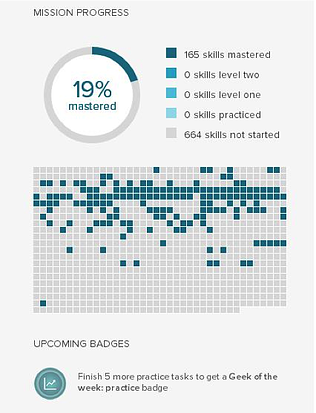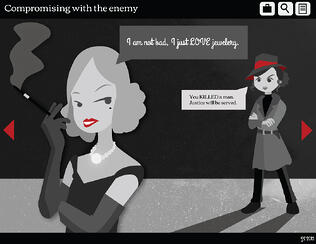Blog
Free Online Courses to Exercise Your Brain this Summer
by Hannah von Bank, instructional writer I’ve always been a writer. As a kid, I cranked out little paper books by the dozens with such titles as “The ...


4 Exercises to Help You Find Your e-Learning Writing Voice
By Hannah Hunter | December 11, 2014 | Custom Learning | 0 Comments

by Hannah von Bank, instructional writer
.png?t=1418319326072&width=120&height=120&name=hannah(250).png)
One of the toughest struggles for all writers is developing an authentic and unique voice, both for themselves and for their characters. A voice encompasses all the unique perspectives, mannerisms, and attitudes that make a piece of writing feel alive. It’s the difference between reading a description of a dastardly character and actually wanting to smack that scoundrel in the face because you hate him so, so very much. A voice is personality and it makes you feel.
While this may sound like pretty lofty stuff, developing a relatable voice is just as important for instructional writers as it is for novelists or journalists. Each course is a character in its own right with a perspective and tone all its own. Sometimes we create characters inside of our e-learning courses as well. The difference, and the challenge, of instructional writing is that we don’t get to do this all on our own. We need to take into consideration the vision of colleagues, clients, and learners. An authentic voice is a huge part of what makes a course relatable and memorable for learners, but incorporating the differing opinions of various project team members often results in courses stripped of all personality in an effort to please everyone.

But, there is a way to write an e-learning course that works for everyone without sacrificing personality and it all begins by setting expectations at the Savvy Start. Here are some brainstorming exercises that you can do at your next project kickoff meeting that will help you and your stakeholders develop an awesome voice for your course:
-
Have each person involved in the project write down three words that describe the way they want the course to feel.
You’ll probably end up with words like fun, entertaining, professional, or casual. Discuss as a group how these concepts can be reflected in the overall writing and theme of the course. Maybe you’ll discover that your team members have very different visions – that’s great! Now everyone can discuss these differences and come up with solutions instead of changing the script after weeks of working on it. -
Or, do the opposite.
What three words does your team absolutely NOT want to apply to this course? This exercise can help unite the group if it seems like there are a lot of opposing ideas. After all, we might disagree on whether the dialogue should feel “casual” or “formal” but no one wants their hard work to be described as “boring” or “monotonous.” Keep these terms, along with the goal terms from the first exercise someplace easily accessible to the whole team. That way if you hit a wall, your team can revisit your shared vision. -
Learn how real people talk.
I love old educational films because I like watching child actors try to convincingly say lines like, “What a pickle! I know drugs are bad for me, but I don’t want to be a square!” In order to write for a teenage audience, it is kind of essential to have actually met a teenager. Writing good dialogue, especially for audio, means understanding how real people speak and interact with each other in a given situation. What kinds of phrases and mannerisms are common among the demographic you are writing for? It might be a good idea to record an interview with a few representatives of your audience or do an onsite visit to a work environment to observe how they act. I’ve even had SMEs write lists of phrases and terms that different roles commonly use.
-
Imagine your course is a real person, then draw them.
With your group, brainstorm how that person might act and look like. What color is their hair? Are they young and hip or distinguished and sophisticated? Where are they from? What kind of clothes do they wear? Do they wear glasses? If your course were attending a potluck, what side dish would they bring? While you are talking, have your most artistically inclined individuals draw that person and their environment.
It seems silly, but once your group has a unified idea of a character, it is much easier to figure out how that character might talk and present themselves.
I know you are all well on your way to creating an engaging and authentic voice for your course, so don’t give up! Just because your content may seem dry, it doesn’t mean your e-learning has to be boring―for you or your learners! It takes a skilled writer—dare I say, a hero?―to take a 160-page Powerpoint on insurance fraud and transform it into an interactive experience that users enjoy and actually learn from. With these tips in mind, you can be that hero.

About the Author: Hannah Hunter
Hannah Hunter is an instructional writer at Allen Interactions. When she’s not sharing her passion for life-long learning, Hannah enjoys painting, experimenting with new recipes, and volunteering as a creative writing tutor for middle and high school students. She also frequently blogs on Allen Interactions’ e-Learning Leadership Blog.
Comments
Would you like to leave a comment?
Related Blog Posts

By: Hannah Hunter | Jul, 2014
Category: Custom Learning

Blog
4 Tips to Maximize Your e-Learning Graphic Designers' Time
by Hannah von Bank, instructional writer I’ve always been a writer. As a kid, I cranked out little paper books by the dozens with such titles as “The ...
By: Hannah Hunter | Jan, 2015
Category: Custom Learning

Blog
3 Real-Life Lessons Learned from Difficult On-The-Job Challenges
by Hannah von Bank, instructional writer I’ve always been a writer. As a kid, I cranked out little paper books by the dozens with such titles as “The ...
By: Hannah Hunter | Aug, 2014
Category: Custom Learning


